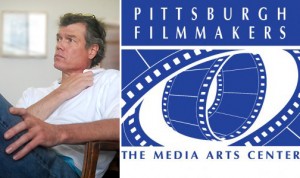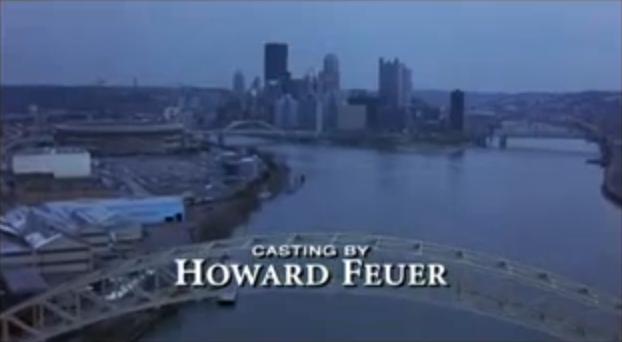 Who: Charlie Humphrey is Executive Director of Pittsburgh Filmmakers/Pittsburgh Center for the Arts in Pittsburgh, Pennsylvania.
Who: Charlie Humphrey is Executive Director of Pittsburgh Filmmakers/Pittsburgh Center for the Arts in Pittsburgh, Pennsylvania.
Pitt film incentives: A 25% tax credit for producers making projects for a national audience who spend 60% of their production budgets in Pennsylvania. No hotel tax if staying 30 days or more, and no surcharge on use of state-owned property for a commercial film.
1) Which films shot on-location in Pittsburgh do you think are most iconically associated with the city?
Humphrey: Pittsburgh and surrounding Western Pennsylvania boast hundreds of movies shot locally — from the silent The Perils of Pauline (1914) to the just-wrapped sci-fi feature, I Am Number Four (2011); from big-budget, large studio productions, to the lowest-of-low-budget independently made films.
 The city can be, and has been, a stand-in for somewhere else. In 1983, for example, the world-renowned Carnegie Museum of Art stood in for a prestigious dance academy in the otherwise fluffy Flashdance. Less than 10 years later, it was recast as the Smithsonian in the Oscar-winning The Silence of the Lambs (1991). But we do, of course, have iconic images that shout Pittsburgh, and only Pittsburgh (the kind where hometown audiences clap with pride). Three Rivers Stadium, the fountain at Point State Park, and the Ohio, Monongahela, and Allegheny Rivers were featured in a sweeping fly-over shot during the opening credits of Groundhog Day (1993). Our rivers and bridges are also prominent in the Bruce Willis action picture, Striking Distance (1993).
The city can be, and has been, a stand-in for somewhere else. In 1983, for example, the world-renowned Carnegie Museum of Art stood in for a prestigious dance academy in the otherwise fluffy Flashdance. Less than 10 years later, it was recast as the Smithsonian in the Oscar-winning The Silence of the Lambs (1991). But we do, of course, have iconic images that shout Pittsburgh, and only Pittsburgh (the kind where hometown audiences clap with pride). Three Rivers Stadium, the fountain at Point State Park, and the Ohio, Monongahela, and Allegheny Rivers were featured in a sweeping fly-over shot during the opening credits of Groundhog Day (1993). Our rivers and bridges are also prominent in the Bruce Willis action picture, Striking Distance (1993).
 Many would argue Pittsburgh’s money shot is the way the city skyline bursts forth upon exiting the Fort Pitt tunnels. This can be seen in The Cemetery Club (1993), Boys on the Side (1995), That Thing You Do (1996), and The Mysteries of Pittsburgh (2008).
Many would argue Pittsburgh’s money shot is the way the city skyline bursts forth upon exiting the Fort Pitt tunnels. This can be seen in The Cemetery Club (1993), Boys on the Side (1995), That Thing You Do (1996), and The Mysteries of Pittsburgh (2008).
Some of our iconography has been torn down. The steel industry and its mills were once associated with this region, but now most are gone. The Deer Hunter (1978), Flashdance, Reckless (1984), Gung Ho (1986), RoboCop (1987), and Iron Maze (1991) are just a few of the films where our steel mills were used as a backdrop. Another iconic structure — on the chopping block as we speak — is the domed sports/concert venue Mellon Arena, originally known as the Civic Arena. It shines in two stinkers, The Fish That Saved Pittsburgh (1979) and Sudden Death (1995).
2) Which independent films are currently shaping how people view the city?
Humphrey: While smaller, independent filmmaking has been going on here for decades (like Stan Brakhage in the early ’70s) — Pittsburgh Filmmakers began as a non-profit organization for artists who wanted access to film and photographic equipment in 1971 — indie filmmaking has taken off in the last 10 years. And indies rarely feel the need to turn Pittsburgh into someplace else. Here are four feature-length indie films, all of which enjoyed some degree of success outside the region, that revel in their location:
 Physician and filmmaker, Dr. Ravi Godse shot his third comedy If It Ain’t Broke, Break It (2009) here with Steve Guttenburg, Richard Kind and Cheetah Girl Sabrina Bryan. It features more scenic shots of the city than close-ups of his celebrities.
Physician and filmmaker, Dr. Ravi Godse shot his third comedy If It Ain’t Broke, Break It (2009) here with Steve Guttenburg, Richard Kind and Cheetah Girl Sabrina Bryan. It features more scenic shots of the city than close-ups of his celebrities.
The Bread My Sweet (2001) starred Scott Baio and Kristin Minter. Filmed in the city’s Strip District, it’s a romantic comedy set in a Pittsburgh bakery.
California-based filmmakers Kyle LaBrache and Chris Bradley came to Pittsburgh in 2004 to shoot Pittsburgh (2006) about actor Jeff Goldblum’s return to his hometown to star in theater production of The Music Man.  This deadpan comedy, which shows off Pittsburgh as a sparkling cultural center, walks a fine line between improvisation, documentary, and re-enactment.
This deadpan comedy, which shows off Pittsburgh as a sparkling cultural center, walks a fine line between improvisation, documentary, and re-enactment.
My Tale of Two Cities (2008) is a valentine to Pittsburgh. It chronicles Carl Kurlander’s mid-life crisis and his decision to leave his life behind as a Hollywood screenwriter (St. Elmo’s Fire, Saved By The Bell) to move back home. It stars the city of Pittsburgh.
Diabolique & Kingpin were pretty good too, cuz I was in them
Diabolique & Kingpin were pretty good too, cuz I was in them